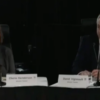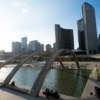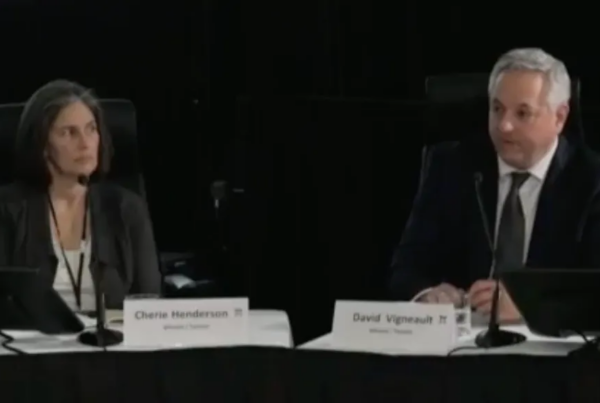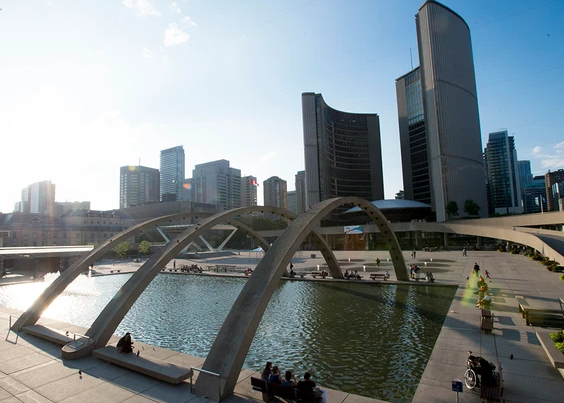Introduction This is the third Institute foray into the black market; the other two being Sin-Tax Failure: The Market in Contraband Tobacco and Public Safety (January 1994) and Mis-Fire: The Black Market and Gun Control (May, 1995). By now, the basic dynamics of an underground economy have become easy to understand, but never before has contraband activity seemed so flagrant in the province.
In Canada, and in Ontario particularly, there is a tradition of experimentation in social engineering through legislation. Value conflicts, idealistic crusades, a persistent (but changing) political elite and a government sense that the populace must be controlled have had a number of effects. Repeated lessons about the role of paradox in guiding human affairs seem to be forgotten shortly after they are learned.
In recent years, attempts to curb smoking through increasingly heavy sin-taxes had some part in gradually diminishing tobacco use – but then a huge black market in tobacco appeared. Currently, consecutive federal governments have pushed gun control only to create a burgeoning black market and drive an unknown percentage of the legally owned inventory underground. Career criminals were connected to the firearms black market even before Bills C-17 and C-68 came down.
The classic North American experiment in forcing social change through legislation came out of the Prohibition Era. A middle class with recent rural ties endeavoured to force anti- alcohol “Temperance” values on the whole of society. The United States added the prohibition of alcohol to their Constitution in 1919. Some 13 years later, after teaching millions of citizens to casually break the law and turning scattered poorly organized criminal gangs into a powerful syndicate (the Mafia), the whole experiment was called off.
Various Canadian provinces flirted with temperance laws and prohibitions of their own- usually to find, then as now, that ordinary Canadians can be remarkably subversive when it comes to government regulation of their private affairs.
Ontario itself instituted Prohibition measures from 1916 to 1927. However, Ontario’s wineries were specifically exempted, and many breweries and distilleries remained open to serve the export market (anyone with access to a doctor might be able to beg for a prescription of rum or whiskey for “medicinal” purposes). The export market boomed with prohibition in the United States. Shipment upon shipment left Ontario, with excise taxes paid, handled by residents who were not allowed to touch a drop of the stuff themselves.
The end of Ontario’s prohibition experiment only came gradually. Many residents remember an entire series of asinine laws and regulations, many of which were enforced by the newly created Liquor Control Board of Ontario (LCBO) and the Liquor Licensing Board of Ontario (LLBO).
For example, until about 1970, Ontario’s bars were required to have a separate Ladies entrance and a room where escorted gentlewomen might enjoy a beverage with a respectable male companion. Otherwise, alcohol-inflamed men might attempt to take liberties… Lest maddened drinkers fall to unseemly brawling, it was forbidden for a patron in a bar to ever stand up with drink in his hand. Ifhe wanted to move to another table, a waiter had to carry his unfinished drink for him. These measures finally ebbed in the 1970s. Limits on glass sizes for draft beer, and the numbers of drinks per person allowed on a table lasted into the 1980s.
The Lord’s Day Act and controls on the public consumption of alcohol also lasted until the 1980s. All taverns and bars were closed on Sundays (starting at midnight on Saturday), and no alcohol could be sold in restaurants – unless sold with food. This resulted in over-handled food items such as stale sandwiches sitting on the tables of drinkers. Outdoor patios, cafes and beer gardens were virtually unknown in Ontario until the 1980s. Likewise, restaurants were forbidden to cook with alcohol until the 1970s, lest forbidden nectars suddenly incite intemperate behaviour among diners.
LCBO stores (the only places were liquor and wines were legally sold), were Calvinistically dreary places. Consumers were not allowed anywhere near the shelves lest they become overwhelmed with thirst and temptation – never mind choice. Instead customers had to fill out a little card with their desires and hand it to a clerk, who would then disappear into the rear of the store and hopefully re-emerge with the right products – packed (by regulation) in a plain brown paper bag. Until the late 1960s, the cards had to be signed and the customer’s address had to be clearly marked.
War-time rationing of alcohol seemingly extended well into the 1950s at LCBO stores. A customer could leave with two bottles of spirits or two cases of beer, nothing more. Revolutionary marketing concepts such as brand displays, comparative pricing, check-out counters and attractive premises made a tentative appearance in the late 1960s and only became universal iri the early 1980s.
In addition to all the strange regulations, Federal and Provincial governments heaped a number of taxes and duties on alcohol, and continue to keep them high. Currently, only a few restrictions remain on consumer choice, but prohibition’s hangover still affects brewers, vintners and distillers. The production and sale of alcohol in the Province are still tightly controlled – but a number of minor quirks (usually representing half-hearted attempts to improve matters) have crept into the system. Taxes and duties have created a vast gulf between real production costs and consumer prices, and regulations are both complex and mixed in their applicaton. The certain and sure result of both is today’s black market.
The Font of the Black Market
An underground economy is based either on the provision of wholly illegal products (narcotics and automatic weapons for example) or otherwise legal products through illegal means. The latter kind of black market is invariably the bastard child of over-taxation and over-regulation. Consumers have demands that will be met. If the price is too high or is inflated artificially through taxes and duties, alternative sources will emerge. If compliance with regulations is seen as a burden, consumers and suppliers will subvert or ignore them. If regulations are regarded by some as unfair, or seem too complex, they will be bypassed.
Whether this seems deserved or not, Ontario’s black market in alcohol owes its existence to the Federal and Provincial governments. Acting in loose concert, Ottawa and Queen’s Park have artificially inflated the price of alcohol with high duties and taxes, while convoluted policies have created significant problems of their own. The underground sale of illegal or untaxed alcohol is a problem throughout Canada, but seems especially prevalent in Ontario. The province is Canada’s most populous (over a third of all citizens live here) and contains 10 of the country’s 25 largest metropolitan areas. Transportation links to the US are excellent, and some good smuggling routes are very hard to adequately police.
As an example of Canadian taxing structures and alcohol, the Association of Canadian Distillers helpfully drew up a little chart in their 1996 Annual Statistical Report. It concerns the pricing of a “typical” 750ml bottle of standard Canadian spirits:
A) A completed bottle of Old Panther Sweat Sipping Whisky arrives at the retail outlet; total production and shipping costs (allowing for a decent profit by the concerned parties) equals some $3.43.
B) The Federal Government adds $3.32 in Federal Excise Duty
C) The Provincial Government tacks on $9.63 in sundry taxes
D) The combined Provincial and Federal Sales taxes add on another $3.12.
It is easy to see how some cunning fellow can make a substantial profit out of a $3.43 bottle of whisky, when the legal price comes out to $19.50. It is also easy to see how many Canadians who (rightly) regard themselves as over-taxed have no difficulty with the presence of a black market. Beer and wine prices are not quite as inflated by taxes as spirits, but the difference is still enough to create a black market in these commodities.
“The Economic Impact and Taxation Burden From the Distilled Spirits Industry”, a January 1996 paper from the Conference Board of Canada, pointed out that a model firm could produce a litre of beer, wine and spirits for $0.62, $1.19, and $1.53 respectively. These figures ,discount profits, but are illuminating all the same. Once all the duties, levies, Provincial mark-ups and taxes are stirred into the mix, the Canadian consumer usually chokes down prices of $3.58, $7.59 and $26.42 per litre.
As always, a black market is a danger. Firstly, the necessary laws pertaining to consumer safety are over-looked or evaded. Secondly, a clandestine trade represents free money to those who care to orchestrate it – and those who do so often come from large and diverse networks of organized crime. The foremost danger from a black market is the effect it has on consumers. It conditions them to evade the law and hold regulations in contempt. It teaches them that the authorities are slow and almost helpless; to tolerate criminal behaviour, and suggests that one can routinely deal with criminals without personal risk.
The presence of a black market should encourage governrrients to examine their taxation and regulatory structures. Otherwise, they are begging for real trouble.
The Extent of the Black Market
It is invariably difficult to gauge the size of a black market. In 1994, according to Statistics Canada, the average Canadian spent $367 on alcohol. Accordingly, 10,928,0000 Ontario residents would have generated some $4,010,576,000 in sales. Actually, Canadians may be fibbing when talking to Statscan (not a surprise really), as the LCBO insists that the actual overall Ontario alcohol market is worth about $5.9 billion a year.
The January 1996 Conference Board of Canada study on the spirits industry estimated that 1993/94 Canadian alcohol sales amounted to $10,523,499,000. However, the study appears to examine only the legal market and does note some incongruities that could only be due to the presence of a large black market.
However much residents may drink, the official share of the market was something less than the whole. For example:
• The Addiction Research Foundation (ARP) Research Document 131 estimated that 19.5% of Ontario’s market was served by “unrecorded” sources in 1990-95.
• The LCBO itself declared in the summer of 1997 that the black market in Ontario was costing the organization some $644 million a year in revenues and accounted for 11 % of the market. This may have been a conservative estimate, as it doesn’t account for product diversion and the almost unregulated production from U-Brews and U-Vints.
• The Association of Canadian Distillers estimated in 1996 that 25% of all spirits consumed in Ontario are smuggled.
• The Canadian Wine Institute reported a steady decline in the consumption of bottled and bulk table wines from 1990 to 1993. They surmised that 51% of Ontario’s wine was coming from concentrates and grape juice used by the U-Vint industry.
These estimates suggest that the black market may divert anything from $782-1,151 million (ARP estimates) to $441-649 million (LCBO estimates) from the province’s legal sales. The ARP estimates show their homework and are probably more accurate. They are also based on data from 1994/95 and the problem has grown since then.
More particularly, the black market is found among consumers. An Etobicoke storeowner, Constantine normally consumes one 1.75 litre bottle of black market vodka every week. Every two weeks, his supplier comes around to his home with two bottles and a carton of contraband Marlboroughs. Constantine feels that” We are taxed too much, way too much, so I keep a little back.” He first went onto the black market in 1993 (in res::>onse to high cigarette taxes), and has been using it for alcohol and cigarettes ever since. After delivering to Constantine one Monday evening, his supplier went to 17 different homes over the next hour and twenty minutes in the same general neighbourhood.
Mark, an employee of a large auto manufacturer near Oshawa, also stocks black market alcohol in his basement bar. “Some of the guys in the Local ask if you want it. You say how much, they either deliver it, or tell you where to meet them in the parking lot [during shift changes]. One guy, he sells it out of his van, and the thing is so low [so heavily loaded], I don’t know how he could make it around. ” Mike and Constantine only represent the thin edge of the wedge.
Val acts as the hostess and sometime bartender at a small restaurant in northern Toronto. Her admission: “We keep afew bottles of underground liquor, lye and vodka mostly, here. My boss [the restaurant owner] keeps more of it at home. Some of the other places around here have been caught, but if they have afew bottles on the premises, it’s just a fine. They don’t lose their licenses.” Who does she serve it to? “Well, the guys who don’t ask for any brand, or have had a couple already – they never know the difference.” Harry, the bartender of a now closed restaurant in downtown Toronto, has another take. “We never sold the cheap stuff, guess I should have.”
Val’s restaurant is not unusual but Harry’s might be: LLBO inspectors catch about 370 establishments a year with contraband liquor.
However, with only 34 or so inspectors, they are unlikely to catch more. Val’s observation about the penalties may not be accurate, LLBO inspectors are supposed to treat every infraction with severity. However, a 1995 KPMG report indicated that LLBO i’1spectors were finding black market alcohol in the full range of restaurants from “low-class bars to international hotels to major restaurant franchises.” Even with only two months offield research backing this study, we can conclusively say that this is the case. The same KPMG report cites the experience of a ] 995 Inspection program in Quebec that used identification kits; it found that 64% of inspected bars in Quebec had illegal liquor. The same might be true in Ontario.
One obvious use of the black market in Ontario’s restaurants and bars comes with spirits. On occasion, smuggled labels can be seen lurking in bars. Product substitution (dumping black market product into legally purchased containers) is much harder to catch. LLBO inspectors rarely can uncover it without res0l1ing to a time consuming audit. The use of U-Vint products in restaurants is even more problematic. Indeed, many establishments are allowed to legally use purchased and fully taxed U-Vint products – but it is virtually impossible to know when un-taxed and illegal U-Vint wines have been substituted.
Many Ontario residents may be consuming black market products without any idea that they are doing so. While the full size of the market is unknown, some observers estimate that between 11 -30% of all alcohol consumed in the province comes from black market sources. Ironically, while LCBO-enforced taxes and regulations have a major role in creating this semi-clandestine industry, the only alcohol that a consumer can truly trust would come from an LCBO store, or directly from an LCBO- controlled producer.
Black Market Spirits Canadian distillers are under attack from two directions. Their conventional market share has been declining over the past two decades, as more Canadian drinkers switched to wine and beer. However, they are also facing a fierce assault from the black market. Distilleries in Ontario have closed or laid off thousands of employees. Their market share has been depressed because of black market competition for almost a decade now, and the trend seems to be worsening.
Unlike beer and wine, spirits are easy to smuggle. The traditional smuggling routes into Ontario come through the Akwesasne Reserve near Cornwall, the Walpole Island Reserve near Sarnia, and through the Niagara Peninsula. The Niagara route often uses the Tuscarora Reserve near Buffalo and the Six Nations Reserve near Brantford as marshalling and distribution points. In the early 1990s, the touchy dynamics of Native politics and the well-armed presence of the Mohawk Warrior’s Society left these reserves exposed to exploitation by organized crime – including Aboriginal mobsters.
In 1993, some $3.6 billion in untaxed cigarettes came through these Reserves. Trading in narcotics, firearms, stolen cars, counterfeit money, illegal aliens and other criminal enterprises was also rife, so long as the Warriors and the “Silkshirts” (criminally oriented entrepreneurs) kept entire communities mutely suppressed. The slashing of cigarette taxes in the Spring of 1994 did much to break the power of the Aboriginal gangsters. It also let elected and traditional leaders re-assert much of their stolen authority.
However, some Aboriginal smugglers stayed in business by concentrating more and more on distilled spirits. This was not as profitable as tobacco smuggling (“butt-legging”) used to be. A calion of cigarettes could fetch about $18-19 dollars from the Bikers or Triad members waiting for delivery. A 1.75 litre bottle of premium alcohol would fetch the same price as a carton of cigarettes, but takes up more space, is far heavier, and is subject to breakage. Thus, the logistics of alcohol smuggling do not make it as profitable as butt-legging, but until cigarette taxes are hiked again, booze keeps the smugglers in business.
Tony Laughing, for example, of the Akwesasne Reserve has been all things in all seasons. In the mid-1980s he reappeared on the Reserve to promote gambling houses (with a partner connected to Mafia activities in Las Vegas), by 1987-8, he was allegedly stockpiling arms for the Warriors. After the Oka Crisis, he was marshalling cigarette shipments from his buildings on the American side of the Reserve, and after the 1994 tobacco tax-cut, he switched to orchestrating alcohol shipments over the St. Lawrence. Other figures from the Mohawk community mentioned in earlier Institute reports have likewise been involved in alcohol smuggling. Currently, Laughing is awaiting trial under America’s RICO statutes for activities connected to the long intimidation and corruption of Akwesasne’s Band government.
As recently as 1995, some police estimated that 95% of all smuggled liquor came through the Reserves, with the bulk of the traffic flowing through Akwesasne. Since then, the RCMP and other police forces have made enormous gains in arresting and convicting leading Native mobsters. However, criminal organizations can be remarkably persistent. The low speed boats laden with alcohol (or the snowmobile trains in winter) still cut across the St Lawrence or slip into the reed beds near Walpole Island.
Not all smuggled alcohol comes through Native Reserves. Some smugglers go through the border crossings themselves. The Fort Erie crossing is the most frequently used Smuggler’s tricks include the use of horse trailers (Customs officers do not check too closely for fear of hooves, swishing tails or more noisome dangers). Smugglers may hide alcohol in shipments of large heavy bulk products, or inside bulk-liquid containers. These activities are riskier, and less conducive to large volumes than shipping through Akwesasne. Some smugglers even brazenly drive right through Canada Customs with a load of liquor and a false manifest.
Shipments of alcohol are usually arranged and co-ordinated by organized criminals – in particular, the Russian Mafiya and the Chinese Triads. Canada’s other large organized criminal societies, the Mafia, the Bikers and the Viet gangs, tend to have better relations with the Warriors and normally feed off this conduit. Given the volumes and routes for the vast bulk of black market spirits, it is safe to assume organized crime controls most of this industry.
A minor source of black market spirits comes from illegal internal stills. This sort of activity has gone on for decades – with varying degrees of professionalism and consumer safety. One still in a UoIT fraternity was busy in the late 1970s and early 1980s. The self- deprecating makers of “White Cane” were not involved in a commercial venture and folded up their operations by 1985. Police do find actve stills, often tied to specific products and communities. For example, home-made Italian “grappa” production normally results in one arrest somewhere in southern Ontario every year – often after the distillation process has resulted in a home or garage fire.
Ontario’s place as key part of the route and the principal market for black market alcohol can be confirmed by the vol lime of spirits seized in the Province. In 1994-95, the RCMP reported that 486,972 litres of liquor were seized in Canada – of these, 338,900 litres (69.6%) were taken in Ontario, with a street value of $4,355,000. Canadian authorities normally intercepted less than 5% of black market cigarettes and can expect to recover one smuggled firearm in 15 within a year of its arriving in Canada. These alcohol seizures represent perhaps 6% of the total amount of spirits flowing into the province.
Black market spirits can be hazardous to the consumer – but most products are generally safe, albeit of low quality. Smuggled spirits typically come in large 1.75 litre plastic bottles and sell for half the price of legal spirits. A bottle of “Dixie Belle Gin” or “McAdams Canadian Whiskey” (both are real black market brands) might fetch $20-$25 dollars when delivered to the consumer. Buying the same amount of equivalent quality spirit in the LCBO may cost $45-50. Smuggled spirits are designed for use in bars. They often incorporate built in pouring devices, and have artwork designed to deceive the casual patron as to the origin of the bottle.
These brands, or ones like the equally wholesome “Seafarer Virgin Islands Rum” and “Johrison’s Blended Canadian Whiskey” (likewise real black market names) are produced in New Jersey, Montana or other American states. They are legally manufactured there, and are legally sold to distributors – normally connected to the Mafia and/or Aboriginal gangsters – for shipment into Canada. No doubt, the phantoms of some long departed American officials are chuckling at the irony of US booze being legally handled all the way to the Canadian border before being turned over to smugglers. In America’s 1919-1932 Prohibition Era, the exact process occurred in reverse.
Canadian legal distillers, who have lost thousands of employees because of the black market, are powerless to stop this activity. Yet they may wish to turn to civil actions about false advertising. Most of the brands produced for the Canadian black market are described as a Canadian product that has been imported into the United States and rebottled. Some labels describe the product as being distilled in Canada.
Once the product arrives in the country, its distribution is undertaken by hundreds, if not thousands, of local petty criminals. Passing black market spirits through a licensed tavern, restaurant or hotel is chancy. If the LLBO catches on, the license to sell alcohol might be lifted. However, if only a handful of contraband bottles are behind the bar, the LLBO inspectors are said to be content to levy some lesser penalty rather than go through the enormous work-load of proving a major case. The LLBO, of course, is prepared to act in the event of any contravention. But it may be that, like police officers often do, LLBO inspectors feel deluged with misdemeanours and have begun to turn a blind eye to minor offenses.
Some establishments that rely more on location than reputation will sell black market spirits, lose their license and then close down, to re-open later behind a “new” management team. One restaurant in a seedy Toronto neighbourhood has lost its license four times in two years, but always re-opened. The law is indifferently enforced in this area. The upstairs part of the property houses ladies of negotiable affection, Bikers sometimes drop in and habitues of the bar were most helpful during the Institute’s study on black market firearms. Despite a recent homicide at an establishment next door and a drive-by shooting up the street, the place remains a favorite listening post for the author. Coincidently, a major distributor of black market wine is a few doors away.
It is not unknown for some restaurants to serve up black market alcohol from behind the bar during large functions. For example, a bottle of “Premium Skol Vodka” (a common contraband brand) was spotted at a reception in a most prestigious Toronto hotel during this investigation. Reception halls, clubs and other organizations may often turn to the black market to supply large gatherings – and numerous sightings were made in the course of this study. Indeed, a senior police officer in Eastern Ontario landed in hot water after contraband liquor turned up at his daughter’s wedding reception. The fault may have lain with the caterer.
Normally, black market spirits go direct to individual consumers. Canadian autoworkers in Oshawa, Oakville and in other large plants may be offered them in their workplace (or Union locals), often by the same colleagues who had offered them black market cigarettes in 1992-3. An engineer in a Bell Northern Telecom site is adding to his retirement funds with the same measures. Black market alcohol may be sold under the table at hotels, convenience stores, gas stations, and coffee shops. Again, this is normally done through conduits that opened for black market cigarettes earlier in the 1990s. Some consumers enjoy a convenient home delivery service. These distributors had generally set up their client networks during the height of the black market in tobacco.
Beer Beneath the Table
The size of the Ontario market for illegal/contraband beer is hard to estimate. James Villeneuve, the Director of Regulatory A ffairs for Labatt Breweries, estimates that perhaps 3% of the beer market in Ontario is supplied by the black markets. Perhaps this is so, but there may also be more to the picture.
In April 1993, police in Hamilton found 40,000 cases of beer being sold from a warehouse. The sellers included three figures believed to be associated with organized crime and the relative of a senior executive (since retired) from one of Canada’s two top brewing companies. The relative apparently arranged for a private sale of the cases to West Africa, and arrangements were facilitated with company executives via familial connections. The West African address was a diversion and an excuse to avoid most duties and taxes. The beer apparently never left Canada.
The senior executive was certainly not responsible for the diversion of a seemingly legal international sale. He took pains to let the internal investigation run its course. Normally a story of this magnitude would have captured a fair amount of local media interest – and the corporation was dead set against media coverage of the affair. Unkind gossip in Hamilton newsrooms has it that senior editors and producers debated the merits of covering the story against the very real threat of a loss of important advertising revenues. They supposedly decided to let discretion take the better part of valour. The detectives involved in uncovering the black market sales had been involved in a drug probe, otherwise the diverted beer shipment would not have come to their attention.
Beer can be stolen, but this is also a difficult undertaking as beer is heavy and fragile. Most thefts of beer are minor. A 1989 case where some soldiers from the Toronto Scottish Regiment and Royal Regiment of Canada spirited two tons of Molson’s beer from their Toronto shipping yard is perhaps one of the larger thefts. [n this case, the theft was for private concerns, and the officers of the suspects didn’t know whether to be more appalled at the deed or pleasantly surprised by the soldierly standards of its execution.
Breweries in Ontario, from the established giants to the newest micro breweries, are allowed a “production allowance” to account for wastage, breakage and spillage, and for promotional purposes. Three different individuals gave a figure of3%, 5% and 10% for the allowance. Breweries do tend to use up a lot of the production allowance in breakage- but rarely would the full amount be allotted this way. Indeed, most breweries might break or spill 1% of their production on a very bad day. However; James Villeneuve was quite adamant that the production allowance is properly used. Two former marketing agents said otherwise.
The two former sales reps (one of whom worked for one of the giant breweries, the other for a larger “micro brewery”) confessed that a lot of use was made of the production allowance over the years. In earlier years, preferred customers used to get a 10-15% “bonus” in addition to their regular supplies. This is apparently harder to do now with cases of bottled beer, but the practice appears to be still common with kegs of draft. Several pubs in the Toronto area as well as the managers of some private clubs confess that extra kegs of draft are still available. Only one extremely popular site admitted to receiving frequent “free” cases of beer. Some Uoff fraternities often get free kegs or cases when ordering for large parties.
Other restaurants, clubs and fraternities acknowledge that brewery sales reps aren’t as generous as they used to be and wonder – since the production allowance is apparently still available – where it might be going. Production allowance surpluses are “grey”, in that they are untaxed and can represent a subsidy for a larger order. While economies of scale favour the larger producers, almost all of the brewing companies might be involved in the practice. One brewmaster for a well-known micro brewery privately acknowledged that “We have a lot of ‘breakage ‘ that falls off the back of trucks.” In the defence of his company he added that, so far as he knew, the same thing was true of most every brewery.
An aside: For those who believe no major company would risk the wrath of Ottawa by depriving it of excise taxes, the September 1996 Report of the Auditor General of Canada indicates that Revenue Canada has become sloppy. Most large licensees have gone unaudited in the 1990s, and the Department’s interest in using information gleaned from other sources has waned. However, the board of directors of the Alberta-based Highwood Distillery were remor~elessly hounded by Revenue Canada for missing duties, after the RCMP watched one director divert 13 shipments of alcohol onto the Black Market. (The other directors had no clue that the activity was going on). It does not help when supervising agencies are at once both lax and then unjust when reminded of their duties.
Despite the issue of product diversion, when asked about the leading source of black-market beer, the brewing industry is nearly unanimous in pointing their fingers at the mushrooming U- Brew sector. There are hundreds of U-Brews in the province and the number is growing fast.
The industry is not well regulated and the incentive to stray outside of the law is considerable.
U-Brew stores first appeared in the 1960s, mostly as an adj








